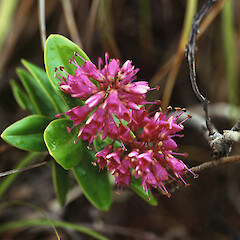Veronica punicea
Common name
hebe
Synonyms
Veronica speciosa var. brevifolia Cheeseman Hebe brevifolia (Cheeseman) de Lange, Hebe macrocarpa var. brevifolia (Cheeseman) L.B.Moore
Family
Plantaginaceae
Flora category
Vascular – Native
Endemic taxon
Yes
Endemic genus
No
Endemic family
No
Structural class
Trees & Shrubs - Dicotyledons
Chromosome number
2n = 118
Current conservation status
The conservation status of all known New Zealand vascular plant taxa at the rank of species and below were reassessed in 2017 using the New Zealand Threat Classification System (NZTCS) – more information about this can be found on the NZTCS website. This report includes a statistical summary and brief notes on changes since 2012 and replaces all previous NZTCS lists for vascular plants.
Please note, threat classifications are often suggested by authors when publications fall between NZTCS assessment periods – an interim threat classification status has not been assessed by the NZTCS panel.
- Conservation status of New Zealand indigenous vascular plants, 2017 . 2018. Peter J. de Lange, Jeremy R. Rolfe, John W. Barkla, Shannel P. Courtney, Paul D. Champion, Leon R. Perrie, Sarah M. Beadel, Kerry A. Ford, Ilse Breitwieser, Ines Schönberger, Rowan Hindmarsh-Walls, Peter B. Heenan and Kate Ladley. Department of Conservation. Source: NZTCS and licensed by DOC for reuse under the Creative Commons Attribution 4.0 International licence.
2017 | At Risk – Naturally Uncommon | Qualifiers: OL
Previous conservation statuses
2012 | At Risk – Naturally Uncommon | Qualifiers: OL
2009 | At Risk – Naturally Uncommon | Qualifiers: CD, ST, OL
2004 | Range Restricted
Brief description
Low sprawling shrub bearing pairs of dark green narrow leaves and short (to 10cm long) spikes of red flowers inhabiting the northern tip of the North Island. Leaves 20-75mm long by 10-25mm wide. Leaf bud without gap at base. Flower spike often with unopened flowers towards the tip.
Distribution
Endemic. North Island, North Cape area only where it is confined to the 120 ha exposure of serpentinite rocks at the Surville Cliffs.
Habitat
Confined to serpentinite (ultramafic) rocks and associated soils of the Surville Cliffs and adjacent plateau, at North Cape. Here it grows in low windshorn scrub, on open clay pans, on boulder fall, adjacent semi-stable scree and along cliff faces.
Detailed description
Low spreading to suberect shrub up to 1.5 x 0.7 m. Branches decumbent, sub-erect to erect, olde stems grey or grey-brown; branchlest green or yellowish, finely puberulent; internodes 1.5-23 mm; leaf decurrencies obscure. Leaf bud without sinus. Leaves patent to erecto-patent, 16-75 x 6-25 mm; upper surface dark green to green, glossy, under side similar but paler and dull; lamina narrowly to broadly elliptic to oblong-elliptic or obovate, coriaceous, flat or m-shaped in cross-section, apex often apiculate, obtuse to subacute, margin finely ciliolate or glabrous, hairy along midrib. Inflorescence a 16-60-flowered, lateral, unbranched raceme, 20-100 mm long, often with many unopened flowers toward apex; peduncle 6-35 mm, rachis 15-75 mm. Bracts alternate (lowermost pair often subopposite), ovate, broadly ovate, elliptic, or narrowly deltoid, obtuse, or subacute. Flowers with pedicels 1-7 mm and always longer than bracts. Calyx 1.9-4 mm; lobes ovate, obtuse or subacute. Corolla tube 3-5.5. mm, hairy or glabrous inside, longer than calyx; lobes magenta to deep violet at nathesis, rose pink or violet with age, ovate, broadly ovate to elliptic, obtuse, erect to suberect, longer or shorter than corolla tube, sometimes hairy inside; corolla throat magenta or violent. Stamen filaments 5.5-10.5 mm, magent or violet; anthers 0.9-1.6 mm, red-purple. Ovary 0.9-1.5 mm; style 7.5-11.8 mm. Capsules 4.5-8.5 x 4-5 mm, subacute, hairy. Seeds 1.7-2.4 x 1.2-1.8 mm, pale to dark brown, broad ellipsoid to discoid, finely papillate, flattened.
Similar taxa
Veronica speciosa is the only other species with similar coloured flowers, it differs by its larger over all habit, much larger broadly elliptic to obovate-oblong or oblong leaves with obtuse to retuse apices, and by the leaf margin, which is distinctly enlarged, red-pigmented, and finely pubescent. Veronica speciosa grows well south of the only known habitat for H. brevifolia - the Surville Cliffs and adjacent ultramafic outcrops of the North Cape Scientific Reserve. H. speciosa has never been found growing on ultramafic substrates, whilst V. punicea is an ultramafic endemic.
Flowering
April - October (but sporadic flowering common all year round)
Flower colours
Red/Pink, Violet/Purple
Fruiting
July- January (but fruits may be present throughout the year)
Propagation technique
Easy from semi-hardwood cuttings. Prefers full sun in a well drained soil. Does best when frequently enriched with serpentinite or high magnesium fertiliser
Threats
Abundant within its only known habitat, the serpentinite rock exposure of the Surville Cliffs, North Cape. This unique habitat is threatened by fires, weed invasions and possums, pigs and feral horses and cattle.
Etymology
veronica: Named after Saint Veronica, who gave Jesus her veil to wipe his brow as he carried the cross through Jerusalem, perhaps because the common name of this plant is ‘speedwell’. The name Veronica is often believed to derive from the Latin vera ‘truth’ and iconica ‘image’, but it is actually derived from the Macedonian name Berenice which means ‘bearer of victory’.
Attribution
Fact Sheet Prepared by P.J. de Lange (1 November 2009). Description based on de Lange (1997)
References and further reading
de Lange, P.J. 1997: Hebe brevifolia (Scrophulariaceae); an ultramafic endemic of the Surville Cliffs, North Cape, New Zealand. New Zealand Journal of Botany 35(1): 1-8.
NZPCN Fact Sheet citation
Please cite as: de Lange, P.J. (Year at time of access): Veronica punicea Fact Sheet (content continuously updated). New Zealand Plant Conservation Network. https://www.nzpcn.org.nz/flora/species/veronica-punicea/ (Date website was queried)
















